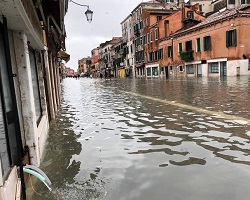Floods across Europe affect thousands

WHO/Lorenzo Lionello
Recent reports of flooding in the WHO European Region have included the highest tide in Venice in more than half a century, as well as communities cut off in Montenegro and people evacuated from their homes in the United Kingdom.
Floods are among the most common natural hazards leading to emergencies in the European Region, with almost all countries having recorded floods over the last 20 years.
As well as causing extensive damage and disruption, floods bring a range of health effects, such as shortages of safe water, poor sanitation, injuries and disruption of access to health services.
Floods can also cause death, for example by drowning, physical trauma and electrocution, among others. Thousands of people have been killed by floods in the Region since the turn of the century and millions more have been affected.
Public health advice on flooding
WHO has published advice for anyone affected by flooding, including measures to take before, during and after a flood to help contain health hazards.
Once flood waters have receded, clean-up operations and the restoration of roads, services and homes should take priority.
An increase in extreme weather events, like heavier and more frequent rainfall, means that floods are expected to happen more regularly and with increased intensity. Governments and local authorities should take measures to prepare for and respond to their impact on health and health services. This includes communicating risks to and engaging with communities before, during and after floods occur.
WHO provides technical guidance and support for emergency preparedness plans and response-and-recovery measures. In 2017 WHO/Europe produced a report advising on how to manage the health risks of floods across the Region.



